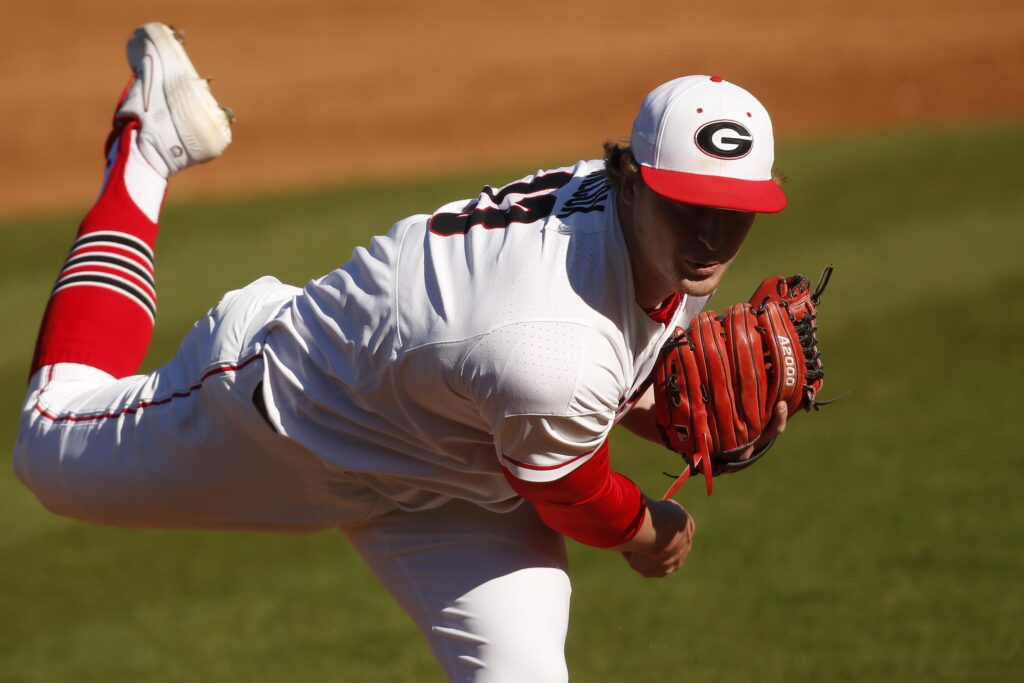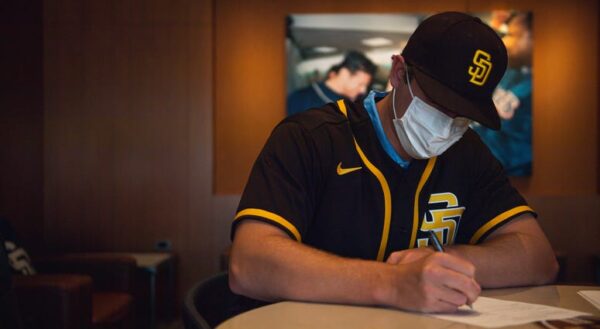Grading the Padres’ 2020 MLB Draft: Cole Wilcox

Credit: AP Photo

The San Diego Padres took a chance on Cole Wilcox and could be rewarded significantly.
Nothing is more exciting for a Major League team than hearing it had the steal of the draft.
Thankfully, in this department, the San Diego Padres have experience.
Last year, they chose Hudson Head in the third round, and many scouts project him as a 20 HR/20 SB centerfielder with a plus hit tool. These factors, according to some baseball writers, such as Fangraphs, have him projected as a top 30 prospect in the future. With another third-round pick, this time in the 2020 MLB First-Year Player Draft, it appears San Diego has yet again secured the steal of the draft.
On Day 2, Preller and company called Cole Wilcox, a Heritage (Ga.) High School alumni who generated first-round buzz in the 2018 draft, and in the process landed one of the best talents available at the greatest value possible. Like in 2018, Wilcox, a student at the University of Georgia before the 2020 June event, was talked about as a first-rounder. But, does he have the front-line starting tools to warrant the loud discussions and, in the process, justify the Friars’ selection of the draft’s best steal? As of right now, I would argue yes because of the immense skill he brings to the organization.
He starts with a very lively fastball, his signature pitch. Routinely clocked at 92-97 mph, Wilcox can pump his heater up to 100 mph on occasion. MLB.com rates his fastball a 65, and not just because it is fast as the name specifies. Instead, MLB Pipeline notes how his number one also features “some sink and arm side run,” which makes it even more lethal to opposing batters. The sink, for instance, fools hitters into believing that a pitch is high enough to be a strike, thereby baiting the hitter to swing at something in the dirt. It also helps with fastballs high in the zone. When a batter thinks a fastball is too high, he opts not to swing; yet, with Wilcox’s sinking offering, the ball moves into the zone for a strike.
Not everyone gives the righty as high of a grade here. The site lastwordonbaseball.com views his fastball a little differently, assigning him a score of 60; however, it praises the speed of the pitch. If the pitch sits consistently in the mid-90s and sometimes reaches 100+ mph, why is it not rated higher?
Well, Wilcox still has room to improve with his primary offering. The most questioned aspect of his fastball is the history it has of being hit harder than expected. Scouts are still split on why this happens, although the inability to control and command it certainly is a leading reason. What could also be happening is that Wilcox’s pitch sequencing is ineffective. In a system with talented defensive catchers, such as the one San Diego has, the righty could learn how to translate the potential of his fastball into production. There is no better way to explaining his fastball than saying it is one of the best in the draft and similar in likeness to aces in the majors.
Besides the electric fastball, the Georgia player relies on a biting slider. Before the 2018 draft, the pitch was labeled a 55 on the point scale. He has only developed the pitch further in college and has learned how to utilize it to devastate batters. Most analysts and writers believe the slider is a plus offering now, rather than merely an above-average one as it was in high school. It has 11-5 movement and ranges from 84-89 mph. Unlike others, his slider becomes nastier as his pitch count increases. This allows him to backdoor lefties, buckle righties, and fool both.
Also, Wilcox possesses a great changeup. Set apart from his peers in high school, the righty has always had a deep repertoire of pitches. From the time he was first seriously scouted to now, he has maintained an above-average third offering. In college, he employed this pitch more so against left-handed hitters than righties. However, it has serious strikeout potential. The incredible movement he gets off the change-up allows him to exploit the weaknesses of enemies.
These assets enabled the 6-foot-5 Georgian to dominate rival schools, whether in the bullpen or in the rotation. Every year that he has been at the University of Georgie, he has struck out more than one batter per inning. In 2019, it was a 9.7 SO/9 ratio over 59.2 innings as a starter and reliever. In other words, he struck out 64 hitters. This year, he became even more sinister to opposing teams, carrying a 12.5 figure. While the sample size was small due to the virus, the increase in strikeouts is impressive since he stopped being a reliever, a role that usually enhances the strikeout potential of a pitcher.
With that strikeout rate and his 1.57 earned run average through four starts or 23 innings, indicated that he was on his way to a significant breakout. As such, the Wilcox deal looks even more like a steal. He may have become the university’s ace, especially as he bettered Emerson Hancock in ERA, hits/9, BB/9, and SO/W while nearly matching his innings pitched and his SO/9. This is in no way concedes to any belief that Wilcox is better than Hancock. Hancock, the 6th overall pick in the 2020 draft, has had a far more illustrious career in college. Instead, the statement is issued as a means of showing that the two Georgia stars have a similar front-of-the-rotation upside. Wilcox, in my estimate as well as other baseball writers, like MLB.com, would have become Georgia’s ace if he refused to sign and opted to enlist for the 2021 draft, considering the breakout potential he had this year.
As with any other pitcher, there are some faults in his game.
For one, his command and control are not always up to par. So, even though he posted more strikeouts than innings pitched, he also issued too many walks. Last year, he surrendered 38 walks or a BB/9 rate of 5.7. While he has vastly improved in this area, bringing his rate to 0.8, or 2 walks through 23 innings pitched, scouts still believe that he needs to clean up his command and control. Who knows if they would have thought differently had 2020 not been a moot year? He was on track for at least a 50 score on his command and control. But, based on his track record, he needs professional coaching to hit the strike zone and specific zones within it more often.
Another issue which compounds his value is his delivery. Most organizations view it as problematic because it features an overhead arm angle, which makes it easier for hitters to track his pitches. The last thing he needs to work on is adopting a pitch which increases his velocity. All of his offerings are in the mid-80s to upper 90s in mph. If he were to gain a curveball that is in the 70 mph range, for say, then he will be able to throw off more batters and reach his lofty ceiling. He has the tools to sit atop a major league rotation, possibly with studs like MacKenzie Gore and Luis Patino.
Grade: A+
Every other team passed on the 20-year-old because he was demanding an excessive amount of money. Unlike most of his peers, he was a sophomore-eligible signee, which meant that he had more leverage than others in the draft, being able to opt-out of any deal and return to Georgia and improve his stock further. However, Preller and his associates were very methodical in how they dealt with the 2020 draft. Even though they agreed to deals with high-ceiling high schoolers with their three first picks, as well with two other amateurs, they saved money with each deal. The Padres’ eighth overall pick, Robert Hassell III, signed for $976,900 under slot value, competitive balance round A selection, Justin Lange, agreed to $148,100 under slot value, second-round choice, Owen Caissie, consented to $450,196, fourth-round option, Levi Thomas, settled for $453,000 under slot value. Fifth-round prize, Jagger Haynes, approved a $98,000 drop in his slot value.
In other words, every other pick that San Diego was signed under slot value, making the acquisition of Cole Wilcox more feasible. On Tuesday, June 30, Wilcox signed with the San Diego Padres for $3.0 million, making this deal the steal of the draft and, no doubt, an A+ for a grade.
I write, I write, and then I write some more.. Lifelong Padres & Chargers fan who is tired of the acceptance of losing that grips all of San Diego sports fans!
Thanks for a very good rundown. There are no sure things in baseball, especially with prospects, but the main ingredient – talent – is there. The Padres will find out about the intangibles, like desire to excel, willingness to adapt, and coachability later.